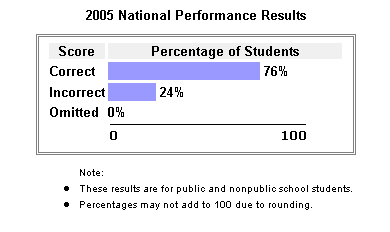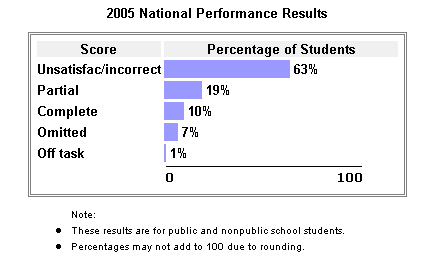Test Yourself Sample Questions: Science Grade 4
INSTRUCTIONS: Find out the correct answers to the questions by looking at the key for the multiple-choice questions or the scoring guide for constructed-response questions. See how your response compares to the actual national response data from the assessment.
Question 1: How do most fish get the oxygen they need to survive?
|
|
A.
|
They take in water and break it down into hydrogen and oxygen.
|
|
|
B.
|
Using their gills, they take in oxygen that is dissolved in water.
|
|
|
C.
|
They get their oxygen from the food they eat.
|
|
|
D.
|
They come to the surface every few minutes to breathe air into their lungs.
|
Correct answer: B You responded:

View the item map to see how this item, which is mapped at scale score 136, relates to the other items on the NAEP scale and to the NAEP achievement levels.
Question 2: Where does water in a lake get most of its energy to evaporate?
|
|
A.
|
The sun heating the lake
|
|
|
B.
|
Green plants living in the lake
|
|
|
C.
|
Streams entering the lake
|
|
|
D.
|
Cold springs under the lake
|
Correct answer: A You responded:

View the item map to see how this item, which is mapped at scale score 154, relates to the other items on the NAEP scale and to the NAEP achievement levels.
Question 3: Pat has two kinds of plant food,"Quickgrow" and "Supergrow." What would be the best way for Pat to find out which plant food helps a particular type of houseplant grow the most?
|
|
A.
|
Put some Quickgrow on a plant in the living room, put some Supergrow on a plant of the same type in the bedroom, and see which one grows the most.
|
|
|
B.
|
Find out how much each kind of plant food costs, because the more expensive kind is probably better for growing plants.
|
|
|
C.
|
Put some Quickgrow on a few plants, put the same amount of Supergrow on a few other plants of the same type, put all the plants in the same place, and see which group of plants grows the most.
|
|
|
D.
|
Look at the advertisements for Quickgrow, look at the advertisements for Supergrow, and see which one says it helps plants grow the most.
|
Correct answer: C You responded:

View the item map to see how this item, which is mapped at scale score 193, relates to the other items on the NAEP scale and to the NAEP achievement levels.
Question 4: The picture shows a way you could hook up a battery, three wires, and a light bulb.

Explain how you could use these things to test an item to see if it is a conductor of electricity.
How could you tell?
You responded:
Complete
Student response indicates that each item should be placed in the gap in the circuit/tester and attached to both clips. The bulb lights up if the item does conduct electricity. If the bulb does not light up, the item does not conduct electricity.
Partial
Student response indicates that the item should be attached to each clip or says the light bulb lights up if the item conducts electricity.
Unsatisfactory/Incorrect
Student response places item on circuit in a place other than between the clips, or description is too general, or student gives unrelated answer.

View the item map to see how this item, which is mapped at scale score 237, relates to the other items on the NAEP scale and to the NAEP achievement levels.